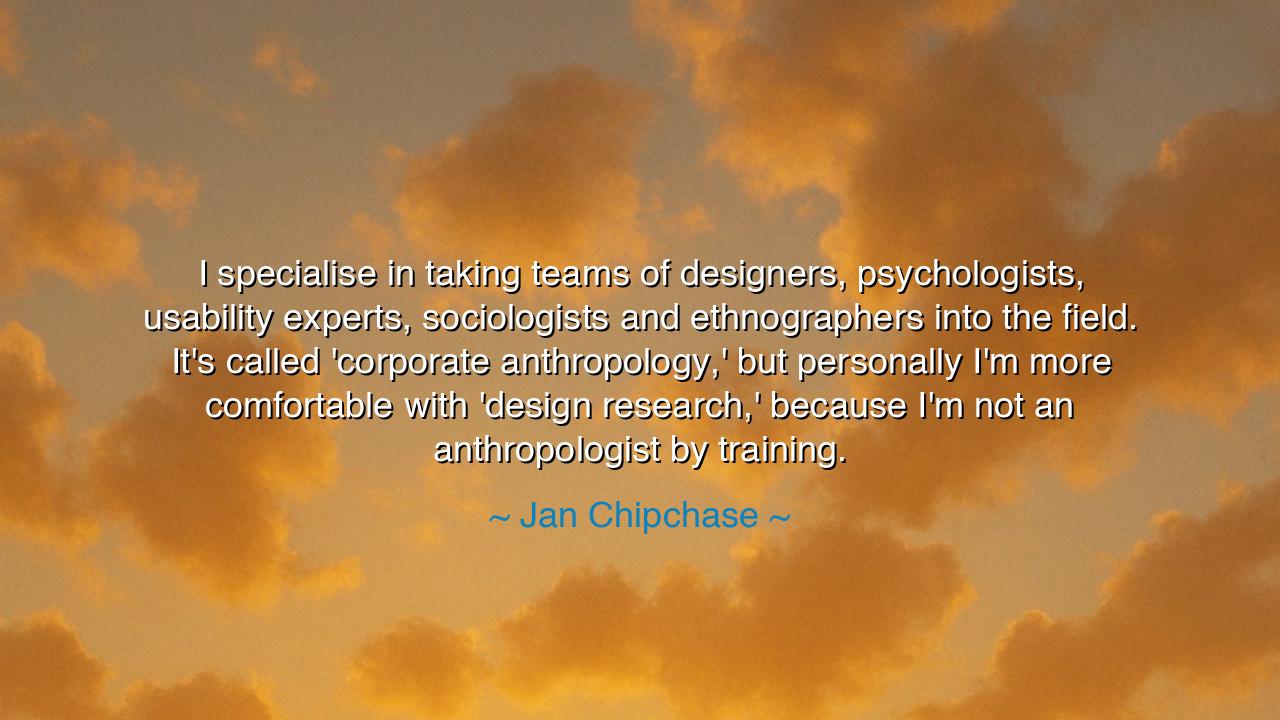
I specialise in taking teams of designers, psychologists
I specialise in taking teams of designers, psychologists, usability experts, sociologists and ethnographers into the field. It's called 'corporate anthropology,' but personally I'm more comfortable with 'design research,' because I'm not an anthropologist by training.






“I specialise in taking teams of designers, psychologists, usability experts, sociologists and ethnographers into the field. It’s called ‘corporate anthropology,’ but personally I’m more comfortable with ‘design research,’ because I’m not an anthropologist by training.” Thus spoke Jan Chipchase, the explorer of modern humanity, whose work moves at the crossroads of technology, design, and human behavior. His words reveal a wisdom that is both practical and profound—that true creation, whether of tools, systems, or societies, must begin with understanding the human heart. For what Chipchase describes is no mere method; it is a philosophy of seeing, of entering the world not as a designer imposing ideas, but as a student learning its rhythms.
When he speaks of “taking teams into the field,” he speaks of a pilgrimage—a journey to witness how people live, adapt, and create meaning in the flow of daily life. In these journeys, the designer becomes an anthropologist, studying not ancient tribes, but the rituals of modern existence. Every gesture—a commuter checking a phone, a farmer tending a crop, a mother teaching a child—becomes data in the grand tapestry of human need. What Chipchase calls “corporate anthropology” is, in truth, an act of reverence: a recognition that to design well, one must first understand deeply. Before we build, we must listen; before we innovate, we must observe.
The origin of this practice lies in the timeless pursuit of empathy. Long before the age of technology, the wisest builders and thinkers knew that invention without understanding breeds failure. The engineers of Rome studied the flow of rivers before they built their aqueducts. The artisans of ancient China studied the motion of hands and posture before shaping tools. Even in the realm of governance, the philosopher-king Marcus Aurelius taught that to rule wisely, one must “enter into the mind of another man and see the world as he sees it.” In every age, the principle endures: that creation divorced from observation is blindness. Chipchase merely brings this eternal truth into the age of machines and markets.
He admits, with humility, that he is “not an anthropologist by training.” Yet in this humility lies strength. For he represents a new kind of thinker—one who moves beyond titles and disciplines, seeking unity between them. By blending the precision of design with the curiosity of anthropology, he has forged a new path: design research. It is the practice of studying how humans actually live, and shaping innovations that honor their behavior rather than disrupt it. This blending of art and science, logic and empathy, is what gives modern design its moral depth. The best technology, he implies, does not shout; it listens. It does not replace humanity; it serves it.
To understand the spirit of Chipchase’s words, we may look to Florence Nightingale, who, though known as a nurse, was in truth one of history’s earliest design researchers. In the battlefields of Crimea, she observed not only the suffering of soldiers but the systems that failed them—the layout of hospitals, the circulation of air, the flow of water. Through observation and empathy, she designed new structures of care that transformed medicine. Like Chipchase, she saw that the key to solving great problems is not in theory, but in watching the world as it is, then daring to improve it. Both she and he understood that true design begins in the field, in the humble act of learning.
There is a quiet heroism in this approach. In a world obsessed with speed and data, Chipchase’s work reminds us of the ancient virtue of patience—of walking among people, seeing with their eyes, hearing with their ears. The designer who practices this form of anthropology is like a gardener, tending the soil before planting seeds. He learns what the earth needs before offering what he believes it wants. This is not merely a strategy; it is a form of wisdom, one rooted in respect for the complexity of human life.
The lesson of Jan Chipchase’s words is both timeless and urgent: to understand is the first act of creation. Whether you are a designer, teacher, leader, or simply a participant in the human story, you must begin by observing with empathy. Go into the field—your field, whatever it may be. Listen before you speak. Watch before you build. Let your work be guided not by assumption, but by understanding.
For in the end, all great design—of objects, systems, or lives—is an act of translation. It is the art of turning what is deeply human into what is beautifully functional. The ancient builders sought harmony between stone and sky; the modern designer seeks harmony between person and tool. Both, if they are wise, know that their true material is not wood, steel, or code—it is humanity itself. And those who honor this truth, as Chipchase does, become not just designers of things, but architects of meaning.






AAdministratorAdministrator
Welcome, honored guests. Please leave a comment, we will respond soon